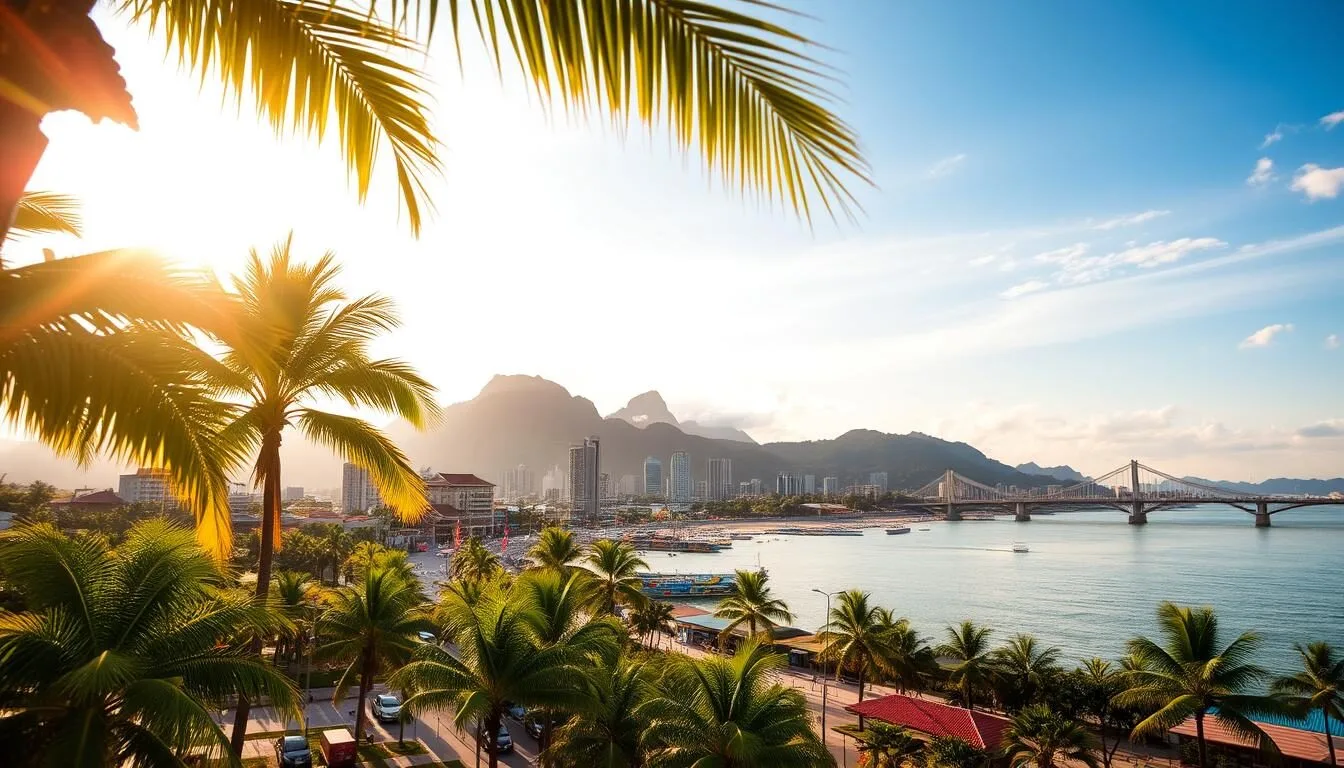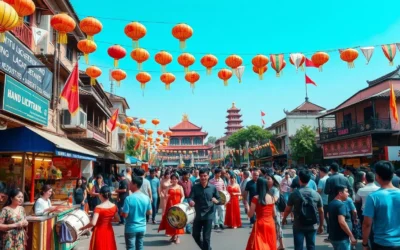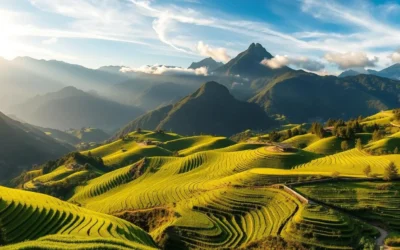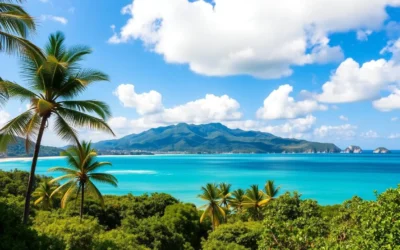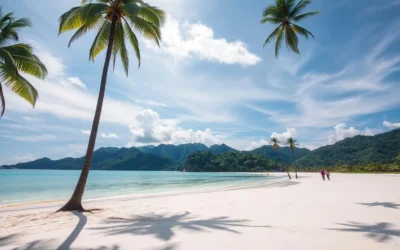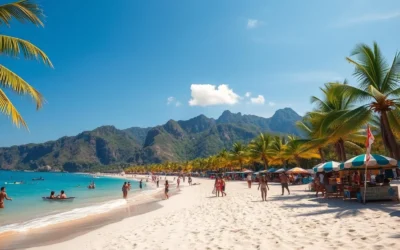✓ Accommodations✓ Flights✓ Rental Cars
You’re not alone; millions of travelers face this dilemma every year. Da Nang, a vibrant city nestled between the azure waters of the East Sea and lush mountains, offers a unique blend of natural beauty and cultural richness.
Timing your visit to this stunning destination is crucial to maximizing your experience. The weather significantly impacts the quality of your trip, whether you’re looking to relax on pristine beaches or explore cultural landmarks.
Understanding the season and weather patterns will help you plan a trip that meets your expectations. In this article, we’ll guide you through the best time to visit Da Nang, ensuring you make the most of your travel plans.
Understanding Da Nang’s Climate Patterns
To make the most of your trip to Da Nang, it’s essential to grasp the city’s climate dynamics. Da Nang’s weather is characterized by a distinct separation between its dry and wet seasons, which significantly influences the visitor experience.
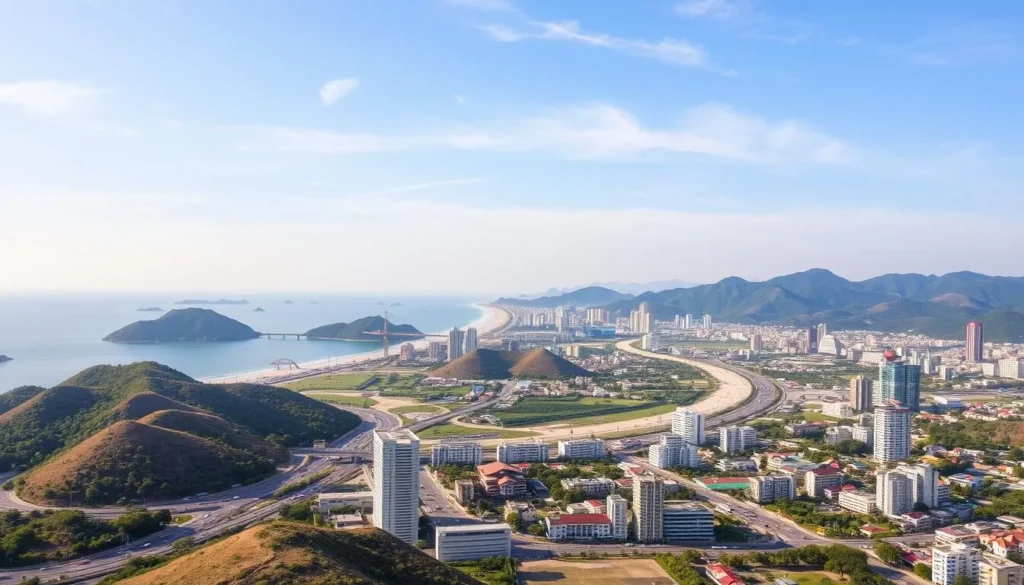
Dry Season vs. Wet Season
Da Nang’s dry season, which roughly spans from December to August, is marked by minimal rainfall and comfortably warm weather, making it ideal for outdoor activities and exploring the city’s stunning beaches and cultural landmarks. In contrast, the wet season, from September to November, is characterized by heavy rainfall and potential typhoons, which might restrict outdoor plans.
During the dry season, you can enjoy clear skies and moderate temperatures, perfect for sightseeing and beach activities. The dry season offers a more favorable climate for tourists, with fewer rainy days.
The wet season, or rainy season, brings significant rainfall and higher humidity levels, impacting the comfort and accessibility of certain attractions. Understanding the transition between these seasons can help you plan your trip more effectively.
Locals adapt to these seasonal changes in various ways, and understanding these adaptations can enhance your experience. For instance, during the wet season, some attractions might be less accessible, but others become more appealing due to the lush scenery.
Da Nang, Vietnam: Best Months for a Weather-Savvy Trip
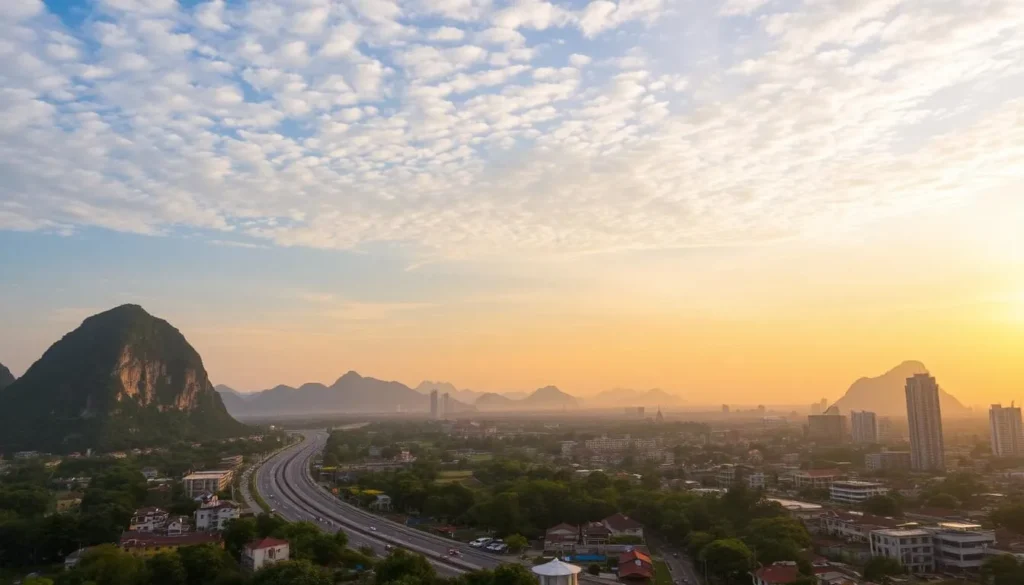
To experience the best of Da Nang, Vietnam, it’s essential to know when to go for optimal weather conditions. The city’s climate plays a significant role in determining the quality of your trip, whether you’re interested in exploring cultural landmarks or enjoying the beautiful beaches.
February to May: The Ideal Window
The period from February to May is considered the best time to visit Da Nang. During these months, the weather is comfortably warm, and rainfall is minimal, making it perfect for outdoor activities and sightseeing. You’ll enjoy clear skies and moderate temperatures, ideal for exploring the city’s stunning beaches and cultural attractions.
The February-May window offers ideal conditions for beach activities, with pleasant water temperatures for swimming and clear visibility for snorkeling or diving experiences. The clear skies and moderate temperatures also create perfect conditions for photography and sightseeing without excessive heat or rain interruptions.
Different types of travelers might prioritize different months within this window based on their specific interests. For instance, beach lovers might prefer the warmer months, while cultural enthusiasts might enjoy the cooler temperatures at the start of the period.
Shoulder Seasons: Pros and Cons
Visiting Da Nang during the shoulder seasons, which include December-January and June, has its advantages. You’ll likely encounter fewer crowds at major attractions and potentially lower accommodation rates, making it a more budget-friendly option. The weather during these periods is still relatively favorable, although there are some drawbacks to consider.
In December and January, occasional unexpected rain showers might interrupt your plans, while June can bring increasing heat and humidity. Despite these potential drawbacks, the shoulder seasons can be a good time to visit if you’re looking for a more relaxed atmosphere and lower prices.
Travelers should be aware that local tourism patterns can affect their experience during these months. Domestic tourism peaks might not align with international travel patterns, and the ideal window for visiting might shift slightly from year to year based on climate patterns and seasonal variations.
Monthly Weather Breakdown in Da Nang
Planning a trip to Da Nang requires a good understanding of the city’s monthly weather patterns. Da Nang’s climate varies significantly throughout the year, making it essential to break down the weather month by month to make the most of your visit.
Winter Months (December to February)
Winter in Da Nang, spanning from December to February, offers cooler temperatures and relatively dry conditions, making it an ideal time for tourists who prefer milder weather. In January, Da Nang experiences a cooler and drier climate compared to the rest of the year, with an average temperature of 20°C (68°F) and 14 days of rainfall. This makes January ideal for exploring the city and its surroundings comfortably.
February marks a transition toward warmer weather, with temperatures rising to 24°C (75°F) and significantly reduced rainfall, averaging only 4 days. This makes February the beginning of the prime tourist season, offering ideal conditions for both beach activities and cultural exploration.
- December: Cooler temperatures, average high of 24°C (75°F), and moderate rainfall.
- January: Mild average temperature of 20°C (68°F), 14 days of rainfall.
- February: Warmer temperatures, average high of 24°C (75°F), and reduced rainfall (4 days).
Spring Months (March to May)
Spring in Da Nang is considered the golden period, with March and April offering perfect beach weather. May brings increasing heat, with temperatures reaching 29°C (84°F), and the first signs of the approaching wet season with occasional refreshing showers.
- March: Pleasant temperatures, ideal for beach activities.
- April: Continues to offer great beach weather, with temperatures rising.
- May: Increasing heat, with temperatures reaching 29°C (84°F), and occasional showers.
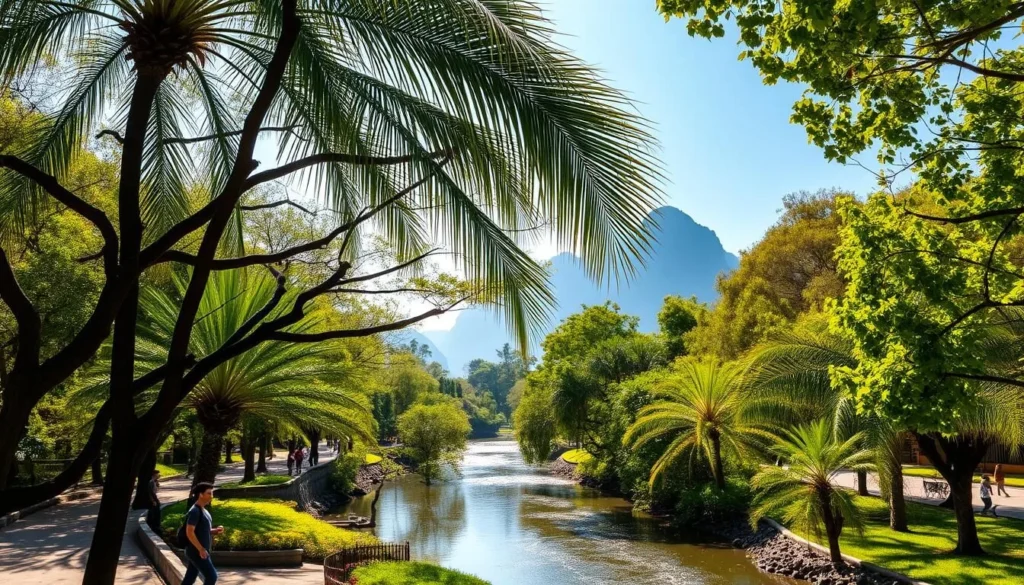
Summer Months (June to August)
Summer in Da Nang is characterized by high temperatures, increasing humidity, and more frequent short rainfall. These conditions can affect different types of activities, and travelers can adapt their plans accordingly. For instance, the frequent short rainfall can be a good time to explore indoor attractions or enjoy water sports.
Fall Months (September to November)
Fall in Da Nang marks the true wet season, with September and October experiencing the heaviest rainfall and potential for typhoons. November begins the transition back to drier conditions, making it a good time to visit for those who prefer fewer tourists and lower prices.
- September: Heavy rainfall and potential typhoons.
- October: Continues to experience heavy rainfall.
- November: Transitioning back to drier conditions.
Understanding the monthly weather breakdown in Da Nang allows you to plan your trip according to your preferences, whether you’re looking for beach activities, cultural exploration, or simply a comfortable climate. Each month offers its unique advantages and special experiences, ensuring that visitors can enjoy Da Nang year-round.
Beach Season: When to Enjoy Da Nang’s Coastline
For those looking to soak up the sun on Da Nang’s beautiful beaches, understanding the best times to visit is essential. Da Nang’s coastline offers a variety of beach experiences, with the weather playing a significant role in determining the quality of your visit.
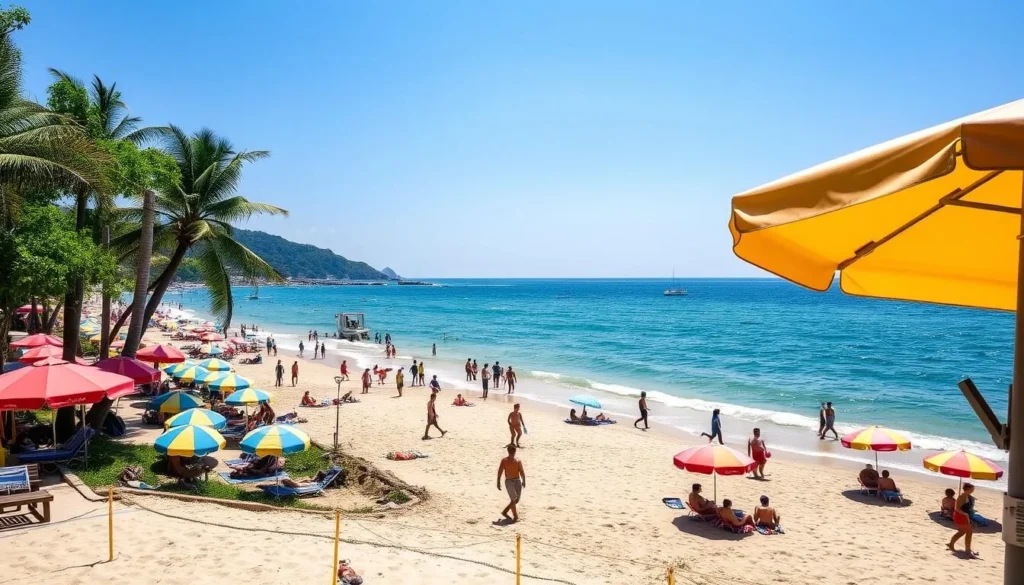
My Khe Beach: Prime Visiting Times
My Khe Beach, known for its 20-mile stretch of white sand and crystal-clear waters, is a must-visit destination in Da Nang. The best time to visit My Khe Beach is from February to August when the weather is dry and sunny, and the sea is calm, making it ideal for swimming and water activities.
The water temperature during these months ranges from 24°C to 29°C, perfect for enjoying the beach. While the peak tourist season is from June to August, the shoulder season (February to May) offers a more relaxed atmosphere with fewer crowds.
Water Activities and Weather Considerations
Da Nang’s coastline is not just about sunbathing; it offers a range of water activities, including surfing, jet skiing, parasailing, and stand-up paddleboarding. The best time for these activities depends on the weather conditions. For instance, surfing is best from September to March when the waves are stronger, while snorkeling and diving are optimal from April to July due to clearer waters.
It’s also important to consider safety when engaging in water activities. Always check the weather forecast and be aware of any warning flags. Lifeguard services are available during peak season, adding an extra layer of safety for visitors.
Cultural Attractions and Weather Impact
Da Nang’s cultural attractions are a treasure trove of experiences, with the weather playing a significant role in shaping your visit. Understanding how weather conditions impact these sites will help you plan your itinerary to maximize enjoyment, regardless of when you visit.
Marble Mountains: Best Viewing Conditions
The Marble Mountains are best visited during the dry season, from February to April, when comfortable temperatures, clear visibility, and safe climbing conditions make for an ideal experience. Be cautious during the wet season, as the limestone surfaces can become slippery, potentially challenging for visitors with mobility concerns.
Dragon Bridge and Han River: Optimal Visiting Times
The Dragon Bridge’s spectacular fire and water shows occur every weekend at 9 PM. Seasonal factors like wind patterns or rainfall might affect viewing conditions. The Han River offers varying photographic opportunities, with morning mist in winter, dramatic storm clouds during the rainy season, and vibrant sunset reflections during the dry months.
Museums and Indoor Attractions for Rainy Days
On rainy days, Da Nang’s excellent museums and indoor attractions, such as the Cham Museum, Da Nang Museum, and Fine Arts Museum, provide perfect alternatives. These cultural institutions offer a respite from the weather while showcasing the city’s rich heritage.
By adapting your cultural sightseeing plans to typical weather patterns, you can make the most of your visit. Many of Da Nang’s cultural attractions offer unique experiences across different seasons, encouraging you to embrace the seasonal character of the city.
Seasonal Festivals and Events in Da Nang
As you plan your trip to Da Nang, understanding the city’s festival calendar can help you experience the best of its culture and traditions. Da Nang’s rich cultural tapestry is showcased through its numerous festivals and events, which are often tied to the city’s seasonal rhythms.
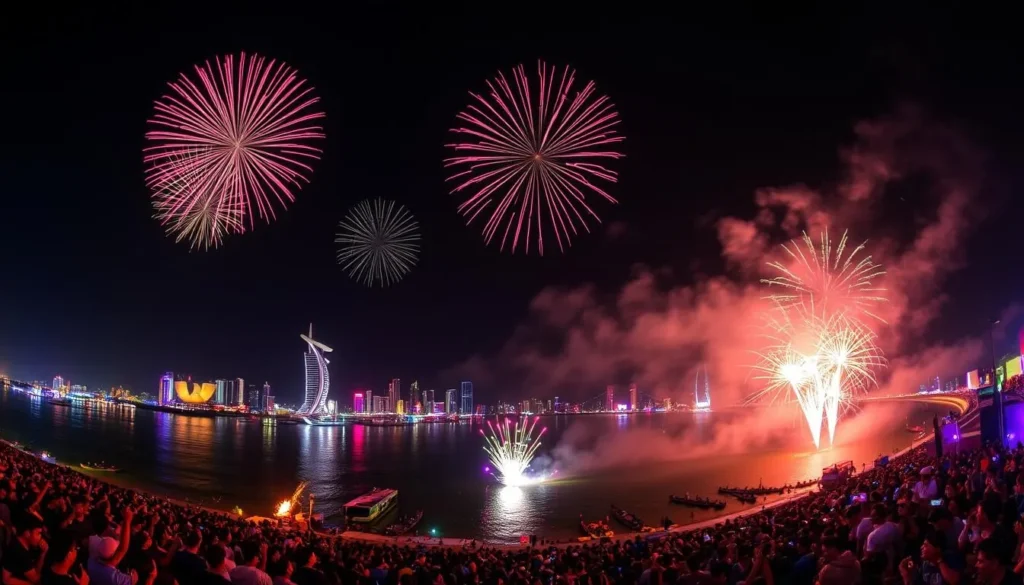
Da Nang International Fireworks Festival
The Da Nang International Fireworks Festival is a spectacular competition held from late April to early June, taking advantage of the dry season’s clear skies and comfortable evening temperatures. International teams light up the night sky with stunning fireworks displays over the Han River, creating an unforgettable experience for visitors.
Tet Holiday Celebrations
Tet Holiday, or Vietnamese Lunar New Year, typically falls in late January or early February, bringing city-wide decorations, special foods, and traditional performances. This major holiday significantly impacts travel logistics and business operations, making it essential to plan ahead.
Other Notable Seasonal Events
Da Nang hosts various other seasonal events, including the Quan The Am Festival on March 19th, the Da Nang Summer Festival from June to August, and the Vietnam Electronic Weekend in July. These events offer a range of cultural and entertainment experiences, from religious festivals to beach-centered activities.
Experiencing a local festival or cultural event can be a highlight of your trip to Da Nang, adding a dimension of cultural understanding that enhances your overall travel experience. With its diverse range of festivals and events, Da Nang is a great destination for travelers seeking a unique cultural experience.
Practical Travel Tips for Different Seasons
When planning your trip to Da Nang, it’s essential to consider the practical aspects of traveling during different seasons. Understanding the city’s climate and its impact on various aspects of your trip can make a significant difference in your overall experience.
Packing for the Season
You should pack according to the season you plan to visit. For the dry season, lightweight, breathable clothing and strong sun protection are must-haves. In contrast, the wet season requires quick-dry clothing, waterproof footwear, and a portable umbrella or lightweight rain jacket.
Transportation Considerations
Transportation options in Da Nang vary by season. During the wet season, roads may flood, making motorbike travel less practical, and flight delays are more common due to weather conditions. It’s a good idea to plan your transportation in advance and stay updated on weather forecasts.
Accommodation Prices by Season
Accommodation prices in Da Nang fluctuate significantly with the seasons. Rates can double or triple during peak season (June-August) compared to the rainy season (September-November). For example, a hotel room might cost $50 per night during the off-season but rise to $150 per night during peak season.
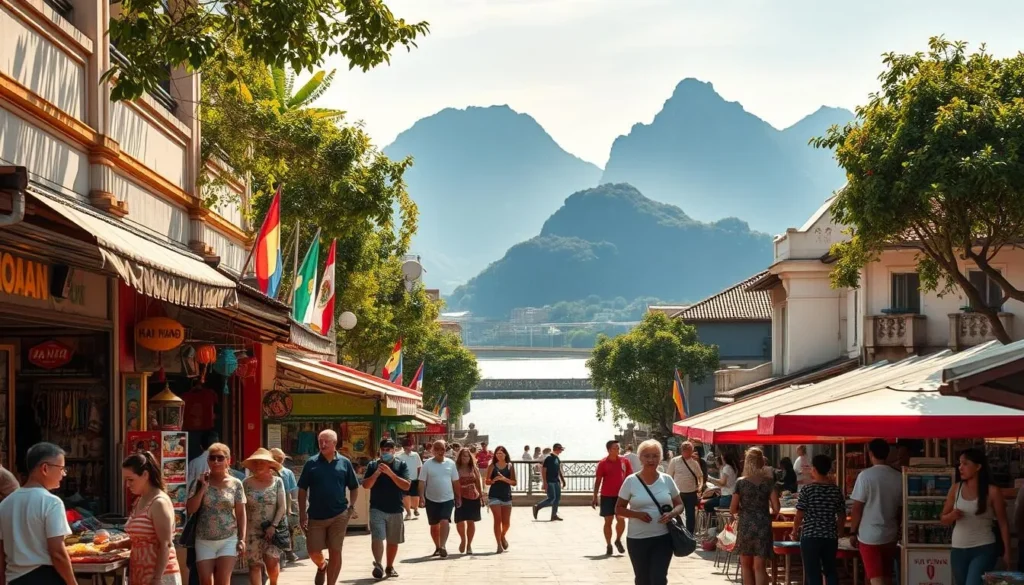
- Be prepared for crowds and wait times at attractions during peak season.
- Take advantage of indoor shopping centers during rainy periods.
- Enjoy seasonal food availability and culinary experiences.
- Always have cash on hand as many local vendors prefer cash transactions.
By being aware of these seasonal variations, you can better plan your trip to Da Nang and make the most of your travel experience in this beautiful city.
Itinerary Suggestions Based on Weather
When planning your trip to Da Nang, understanding the weather can make all the difference in enjoying your vacation to the fullest. The city’s climate significantly influences the activities you can enjoy and when.
Dry Season Delights
During the dry season, from February to May, Da Nang is at its best. You can enjoy a 3-day itinerary that includes early morning beach time, exploring the Marble Mountains at midday, and watching the Dragon Bridge fire and water show in the evening. This balance allows you to experience the city’s natural beauty without exhaustion.
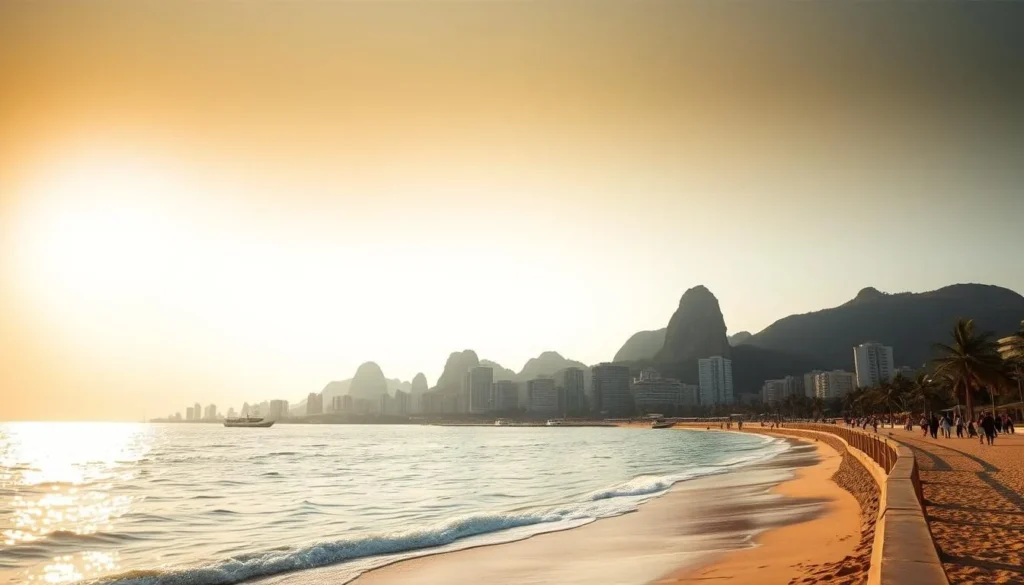
Rainy Season Alternatives
Even during the rainy season, Da Nang offers unique experiences. You can schedule outdoor activities like visiting the Marble Mountains during the drier morning hours and switch to indoor activities like cooking classes or museum visits during the wet afternoons. This way, you can still enjoy the city’s culture and beauty.
| Activity | Dry Season | Rainy Season |
|---|---|---|
| Beach Time | Early morning | Limited to drier days |
| Marble Mountains | Midday | Morning |
| Dragon Bridge Show | Evening | Evening |
| Cooking Classes | Optional | Afternoon |
Conclusion
Whether you’re looking for beach relaxation or cultural exploration, Da Nang’s climate plays a significant role in shaping your travel experience. The ideal time to visit is from February to May, when temperatures are comfortably warm and rainfall is minimal. Understanding Da Nang’s seasonal variations allows you to make informed choices based on your preferences and budget. With its growing infrastructure, Da Nang is a year-round destination, offering a unique experience regardless of the season. By planning wisely, you can maximize your enjoyment and minimize weather-related disappointments during your trip.
The above is subject to change.
Check back often to TRAVEL.COM for the latest travel tips and deals.
